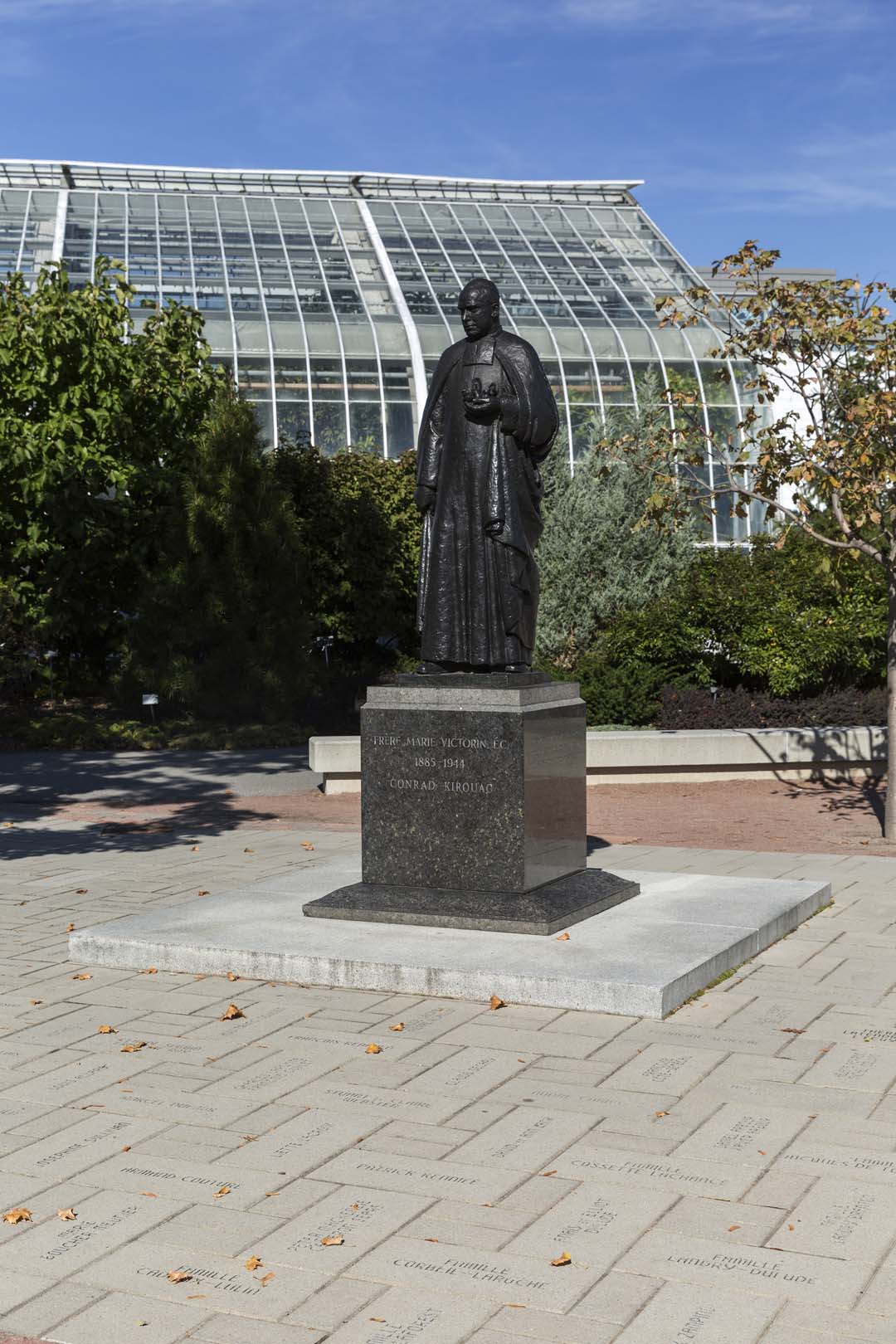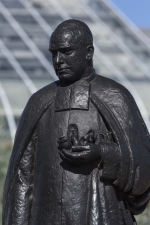Sylvia Daoust
Monument au frère Marie-Victorin
1951
Presentation of the artwork
The monument portrays Brother Marie-Victorin standing in a reserved and familiar pose that is a classic of Western statuary. The priest is in a walking stance, the right foot stepping forward, as if he were peacefully strolling down the paths of the Botanical Garden. Wearing the robe and skullcap typical of the priests of the Christian Schools, he has his right hand on the cape that covers him, and in his left hand he holds a pitcher plant, his favourite flower. His pose conveys, in the simplest terms, a life of passionate research and work to complete the inventory and study of Québec flora. In this portrait, executed from old photographs, sculptor Sylvia Daoust expressed Brother Marie-Victorin’s two dominant passions: religion and botany. She captured in bronze an important facet of his personality: that of the intellectual who made a decisive contribution to the advance of scientific research in Québec. Associated events
Born in Kingsey Falls, Brother Marie-Victorin (1885–1944), born Conrad Kirouac, was the founder of the Institut de botanique at the Université de Montréal and the Montréal Botanical Garden. He conducted scientific research on the flora of Québec. He published Croquis laurentiens in 1920, followed by Flore Laurentienne in 1935. The latter book is still the reference on the subject today, and it is reprinted regularly. An eminent member of the international scientific community, Brother Marie-Victorin received the Prix David du Québec for his body of research on flora in 1923 and 1931, the Prix Gandoger from the Société botanique de France in 1932, and the Prix de Coincy from the Académie des sciences de Paris in 1935.
Sylvia Daoust
Born in 1902 in Montreal and died in 2004, Sylvia Daoust was the first woman to register at the École des beaux-arts de Montréal, in 1923. She taught drawing, anatomy, modelling, and sculpture at the École des beaux-arts de Québec from 1930 to 1943, and sculpture in wood and stone at the École des beaux-arts de Montréal from 1943 to 1968. She stood out very early as a portraitist and statue maker, favouring direct carving on wood. Throughout her career, religious art was her main area of expression. Aside from the monument to Brother Marie-Victorin, among her artworks produced in Montréal are the statues of Marguerite Bourgeoys and Marguerite d’Youville at the Notre-Dame basilica, the statue of Jeanne d’Arc at St. Joseph’s Oratory, and the monument to Édouard Montpetit at the Université de Montréal.
Awards and honours
- Prix de sculpture au Concours interprovincial Lord Willingdon (alors Gouverneur général du Canada), 1929
- Médaillée de l'Institut royal d'architecture du Canada., 1961
- Prix Philippe-Hébert de la Société St-Jean-Baptiste., 1975
- Médaille d'Or, Hommages du Conseil de la Cité de Dorval., 1975
- Le Mérite diocésain Monseigneur Ignace-Bourget., 1983
Presentation of the artwork
The monument portrays Brother Marie-Victorin standing in a reserved and familiar pose that is a classic of Western statuary. The priest is in a walking stance, the right foot stepping forward, as if he were peacefully strolling down the paths of the Botanical Garden. Wearing the robe and skullcap typical of the priests of the Christian Schools, he has his right hand on the cape that covers him, and in his left hand he holds a pitcher plant, his favourite flower. His pose conveys, in the simplest terms, a life of passionate research and work to complete the inventory and study of Québec flora. In this portrait, executed from old photographs, sculptor Sylvia Daoust expressed Brother Marie-Victorin’s two dominant passions: religion and botany. She captured in bronze an important facet of his personality: that of the intellectual who made a decisive contribution to the advance of scientific research in Québec. Associated events
Born in Kingsey Falls, Brother Marie-Victorin (1885–1944), born Conrad Kirouac, was the founder of the Institut de botanique at the Université de Montréal and the Montréal Botanical Garden. He conducted scientific research on the flora of Québec. He published Croquis laurentiens in 1920, followed by Flore Laurentienne in 1935. The latter book is still the reference on the subject today, and it is reprinted regularly. An eminent member of the international scientific community, Brother Marie-Victorin received the Prix David du Québec for his body of research on flora in 1923 and 1931, the Prix Gandoger from the Société botanique de France in 1932, and the Prix de Coincy from the Académie des sciences de Paris in 1935.
Sylvia Daoust
Born in 1902 in Montreal and died in 2004, Sylvia Daoust was the first woman to register at the École des beaux-arts de Montréal, in 1923. She taught drawing, anatomy, modelling, and sculpture at the École des beaux-arts de Québec from 1930 to 1943, and sculpture in wood and stone at the École des beaux-arts de Montréal from 1943 to 1968. She stood out very early as a portraitist and statue maker, favouring direct carving on wood. Throughout her career, religious art was her main area of expression. Aside from the monument to Brother Marie-Victorin, among her artworks produced in Montréal are the statues of Marguerite Bourgeoys and Marguerite d’Youville at the Notre-Dame basilica, the statue of Jeanne d’Arc at St. Joseph’s Oratory, and the monument to Édouard Montpetit at the Université de Montréal.
Awards and honours
- Prix de sculpture au Concours interprovincial Lord Willingdon (alors Gouverneur général du Canada), 1929
- Médaillée de l'Institut royal d'architecture du Canada., 1961
- Prix Philippe-Hébert de la Société St-Jean-Baptiste., 1975
- Médaille d'Or, Hommages du Conseil de la Cité de Dorval., 1975
- Le Mérite diocésain Monseigneur Ignace-Bourget., 1983






